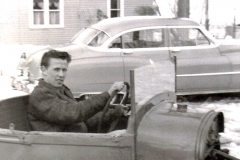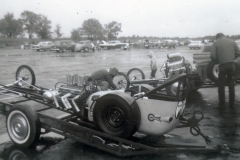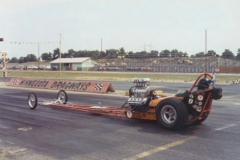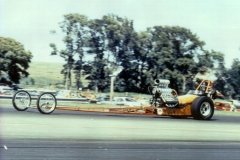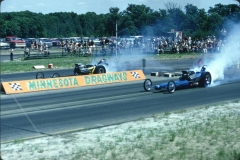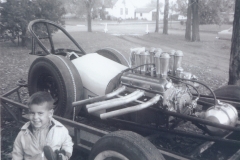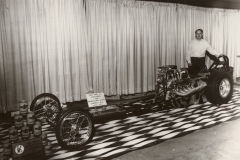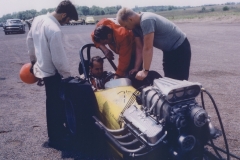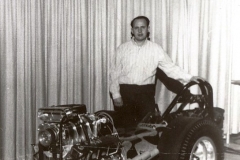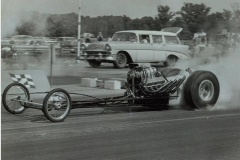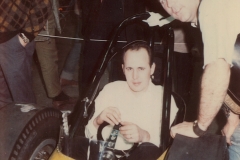Thunder Zone Memories As Remembered by Ky Michaelson
When I was a young boy, I lived right next to the airport in South Minneapolis, which is where they trained the fighter pilots during WWII. I would gaze up into the sky and watch the planes accelerate as they took off from the airport and was amazed at how fast the planes could accelerate. That is when I discovered I had a need for speed!
When I attended Jr. High all that I could think and talk about was being a racecar driver. I would draw streamlined cars and would close my eyes and imagine what it would feel like to go over 200 mph. I would build small cars and install homemade rockets into them, which I made from my Gilbert chemistry set. I would then shoot the cars down the alley where I lived to see how fast they would go.
In 1953, I turned fifteen and saved the money I earned from my paper route, mowing lawns and painting houses and I bought a 1932 Ford three-window coupe for eight dollars from a friend of mine. I thought I was in heaven when I tore the fenders off and installed a Ford truck motor with three Stromberg carburetors It also had high compression aluminum finned heads and a nifty dark gray primer paint job. Now all that I needed was a place to race. The closest track was thirty miles away, but I had no trailer or truck with which to pull it. My other problem was that I had no driver’s license, so one sunny Sunday morning I decided 1` to forget about the minor details and take side roads hoping my loud exhaust pipes would not attract the attention of the local police.
On the way to the track I stopped at a stop sign that was next to a fire station. There was a fireman washing the sidewalk with his fire hose and my first thought was to ask if he would turn his hose on my car and give it a wash job. I asked him if he would. That was a mistake. The water had so much high pressure that it sprayed into the car everywhere. The engine started to sputter. I hollered, “Stop!” as loud as I could and drove away on about five cylinders.
It took me over an hour to get to the track. When I heard the roar of a dragster going down the track my heart started to beat faster. I thought to myself, at last my dreams came true. Then all of a sudden I had a new problem when Don Voge, the owner of the track, asked me how old I was. I told him I was sixteen. He said, “No you’re not! You’re eighteen.” He handed me a piece of paper and a pencil and told me to write a letter from my mother saying it was all right to race. I drove the car up to the starting line. I have to admit I was very nervous, but when the flagman dropped the flag my competitive juices started to flow. I had my first taste of speed, even if my speed was less than 100 mph;
I had reached my goal of racing a car.
While at the track I noticed that the motorcycles were almost as fast as the dragsters. I decided to go with the flow and build a drag bike. My first bike was a 1954 Harley Davidson KHK. I ran my first 100 mph with this motorcycle at Twin City Speedway. I raced this bike for a year winning a few first place trophies.
I went to work at Paul’s Cycle, a BSA dealership in St. Paul, MN. The owner, Paul didn’t like the fact that I was racing a Harley, so he gave me a deal on new 1959 BSA 650cc Spitfire Motorcycle. This bike came from the factory with straight pipes and a high compression engine. It was a beautiful red and chrome bike. I raced this bike in 1960 at Minnesota Dragways and Twin City Speedway for 2 years winning over 35 trophies.
During the off-season I decided to stretch my BSA and add another 650cc bike engine. This was the first dual engine motorcycle in the Midwest. Because of it’s extended length I decided to call it the Centipede. This bike was the fastest motorcycle that I raced to this date. One night at Twin City Speedway I let a good friend of mine, Clem Larson ride the Centipede. When he shifted into 4th gear he accidentally stuck his foot into the rear wheel. He immediately came off the bike and ended up with a little road rash a couple of stitches. The Centipede was completely destroyed.
Because of my interest in drag racing in 1956 I joined a racing club called Gopher State Timing Association. This was the governing body of a number of hot rod clubs in Minnesota. The club saved enough money from holding car shows to buy a top gas dragster from Jack Moss. If you worked on the car you could drive it, so in 1963 I decided to stop racing motorcycles and jump into the seat of the GSTA dragster, it had a short 101 inch wheel base and we named it The Little One. It was powered by a 362 cubic inch small block blown Chevy motor. My first run on the car was 160 mph in nine seconds. I drove the car for the season before I decided to build my own car.
I had a full time job working at Melo-Glaze Bakery, I also had a part-time job at a motorcycle shop and started a company called KM Specialties selling after market motorcycle parts and building motorcycle-racing motors, needless to say I was a busy guy. I lived in a large old farmhouse with no garage and with the cold winters in Minnesota I had no choice but to build my dragster in my basement of my house. I felt like I was working around the clock with all of my jobs so that I could pay my bills and build a dragster. I finished the car, but I had no engine, so my friend Ted Smith teamed up with me and supplied a 301cubic inch injected Chevy on alcohol. I named the car The Miser because of what I had to do to finance the car. We ran the car for a short time, but it was not fast enough for me, so I decided to drive the GSTA car for another year until I could afford a competitive blown racing engine.
We had 5 drivers for the car. It was kind like playing musical chairs because we would flip a coin to see who would drive the car first. The other drivers would make fun of me because I would not drive the car unless I could use the steering wheel out my racecar. They didn’t understand the reason why I would go out of way to change the steering wheel. It was because I wanted to have the feel of my wheel from my car so I could pretend I was driving my car.
The next season I bought a new dragster chassis from California Chassis Engineering. This was a super lite car with a super charged 327 Chevy motor. I competed in the top-gas dragster class. This car proved to be a very competitive car; the only car that could constantly beat me was the GSTA club car. Personally I didn’t think it was fair that I had to race against my own club car because GSTA could afford the best equipment and I could not. I needed the money I won with the car to support my racing hobby, so I started to go out of the State and race. I also competed in the NHRA division five point’s races.
The next year I built an all-new car with a 427 blown Chevrolet. This car had plenty of power and I could light up the tires like a top fuel dragster. Halfway through the season, at about the thousand footmark, I felt a hard vibration. I looked down towards the clutch can and just then the clutch exploded. I pulled both of my feet back as far as I could, but not soon enough. A three quarter inch piece of cast iron from the bell housing hit my foot; it cut right through my shoe penetrating my foot cutting the tendons. It felt like someone hit my foot with a large sledgehammer, needless to say that was the end of my driving for the summer.
I recruited Bill Bisonett to drive the car. He also had a good friend that was a top-notch mechanic by the name of Byron Nelson. We finished the season with a number of wins and for the first time I didn’t have so much pressure on me. It was not easy to drive the car and do most of the mechanical work too. I finally had a chance to sit back and enjoy drag racing. The only time I got nervous was when Bill drove the car. Bill was a good driver but I always worried that if some thing happened he could get hurt. Bill and I became very close friends.
The next season I bought a top fuel dragster chassis from Jerry Boldennow, Frank Hauser of RCS originally built it. It was a super light car and it was equipped with best that money could buy. We built a new 436 cubic inch Chevrolet top gas motor with a new Hampton blower and a new enclosed trailer. Kenny Winters painted the car with a really flashy purple and black sycadelic paint job; after all it was the 60’s. We were loaded for bear and ready to go racing!
When we were not following the NHRA division five circuit, we raced the rest of the season at Minnesota Dragways and North Star Raceway. One of the more memorable moments I had with this car was when we were racing up in Winnipeg, Canada. We were sitting in the staging lines getting ready to race and there were 4 other cars sitting in front of us. A fellow racer by the name of Dave Babler, in his California Woody top fuel car made a qualifying run. The car had a huge explosion, which cut the frame rails on the car and damaged the car severely. I was told that when Dave was working on the car, he accidentally dropped a socket in the clutch can and could not get it out, so he left it in and when he made the run that was the cause of the engine explosion.
At that same time one of my mechanics was adjusting the clutch on my car and he dropped an Allen socket in my clutch can. We tried desperately to get the socket out, but we could not get to it. I really needed the money and we came all of this way and we could not even race the car. I was sitting in the car all bummed out and then it struck me like a bolt of lightening. Why not roll the car upside down on the roll cage and shake the car until the socket falls out! I jumped out of the car and started shouting orders like a drill sergeant. Everyone thought I was crazy when we rolled the car on over on the roll cage and started shaking the car. One of the race officials said that it was too late to run the car. I pleaded with him to give us another minute. Just then the socket fell out of the clutch cam. We rolled the car back on its wheels. Bill jumped back into the car and signal me to push the car to start it. Bill waited for the oil pressure to come up and then he hit the ignition switch. The motor started to sputter. Oil, gas and a lot of smoke were coming out of the exhaust pipes. He kept revving the motor up and it started to fire on all 8 cylinders. The green light came on and Bill qualified the car. I don’t think anyone has ever made this radical of a decision before, but it worked for us.
Every time we traveled out of state I would always say to Bill, “I sure wish I could catch a rattle snake”, and Bill would say, “Michaelson what are you going to do when you catch that rattle snake?” I would joke around and say, “I’m going to take that old snake and twirl it above my head and snap it’s head right off.” Bill would always laugh and say, “I sure would like to get a picture of that!”
When we raced down in Bowling Green, Kentucky there was a carnival right next to the racetrack so I decided to check it out. When I was walking through the carnival I saw a real big, authentic looking rubber snake. I thought to myself, I’m going to buy that snake and get even with Bill because of all the jokes he played on me through the years. We decided to drive back home from the race instead of staying overnight. It was about 3:00am when we stopped to get gas in Wisconsin. Bill was sleeping with his contact lens out in the back of the station wagon. Tom Ferrin was driving the station wagon. As we pulled out of the gas station I noticed thousands of fireflies along side the service road.
I told Tom to pull over because I wanted to try and catch some fireflies and of course I took my big rubber snake with me. I was running through the weeds pretending to catch fireflies. I dropped my rubber snake on the ground and starred screaming, “Snake! Snake! Snake!” Bill sat up in the station wagon and started hollering, “Ky, watch out it could be a Water moccasin!” I pretended to drop the snake and chase it. Bill became more and more upset. I dragged it out for about five minutes.
I finally took the snake and threw it into the back of the station wagon where Bill was. He started screaming and almost went into hysterics; let’s just say I sure got his attention. Tom and I had to jump on top of him so he would not kick out the windows. His heart was beating about ninety miles an hour. After we got Bill settled down he said, “Ky, this is the best joke you have ever played on me.”
Bill reminded me of the time that we were driving up to Canada to race at Bison Raceway, it was late at night and Bill was driving the pickup with a camper on it. He exited off the freeway and headed down a gravel road. We all were very tired so Bill pulled over and parked. The next morning I woke up and looked out the window, Bill had parked right on a railroad track Thank God no train came down the track at night. At the time this happened I thought Bill did this on purpose, so I told Bill that I would get even with him some day. Bill thought scaring him with the snake the next season was my way of getting back at him.
In 1970, I had Bob Myers build me a new 215-inch wheel base car. We chromed and polished ever thing that we could on the car. Dave Dewars built the 465 cubic inch hemi engine, with a Lenco two speed transmition. The car was painted with a beautiful combination of yellow, orange and candy apple red paint. We entered the car in the GSTA Rod and Custom Show and won ‘Best Dragster’ and ‘Best Engine’ trophies. This was a great way to start out the season!
Unfortunately, the rest of the season was not as successful. Halfway through the season we where heading back home from a race in Wisconsin, Tom Ferrin was driving the tow vehicle. We were driving down a long hill when disaster struck. A semi truck drove very close past us at high speed, causing our trailer to violently whip from side to side. Tom tried every thing possible to straighten the trailer out. We eventually went into the median sideways flipping the trailer. The trailer tore away from the tow vehicle and burst into flames. Luckily a wrecker came by and hooked a cable around the roll cage, and pulled the twisted dragster out of the trailer. The only thing that was saved was the engine and drivers compartment. The trailer and all of its contents were a total loss. Needless to say the racing season came to an abrupt end.
The 1971 season, we had Bob Myers build me a new car using the old drivers compartment from the burnt car and extended the frame to 219-inch wheelbase, making it the world’s longest wheel base top gas car. We painted the car black with white lettering that read ‘Michaelson Bissonet Nelson’. I also bought a new rear engine car from Larry Simpson, which I planned on using the next season. Unfortunately 1971 was also the year NHRA dropped top gas from the professional category to make room for pro-stock. Personally, I think if it has doors it’s not a racecar.
About eighteen owners of top gas cars teamed up and formed up a group called the Midwest All Stars. We circuit raced throughout the Midwest for two years and I began to lose interest in circuit racing and decided to go exhibition racing where I was guaranteed to make money. I also had plans to set the world’s fastest and quickest quarter mile record.


